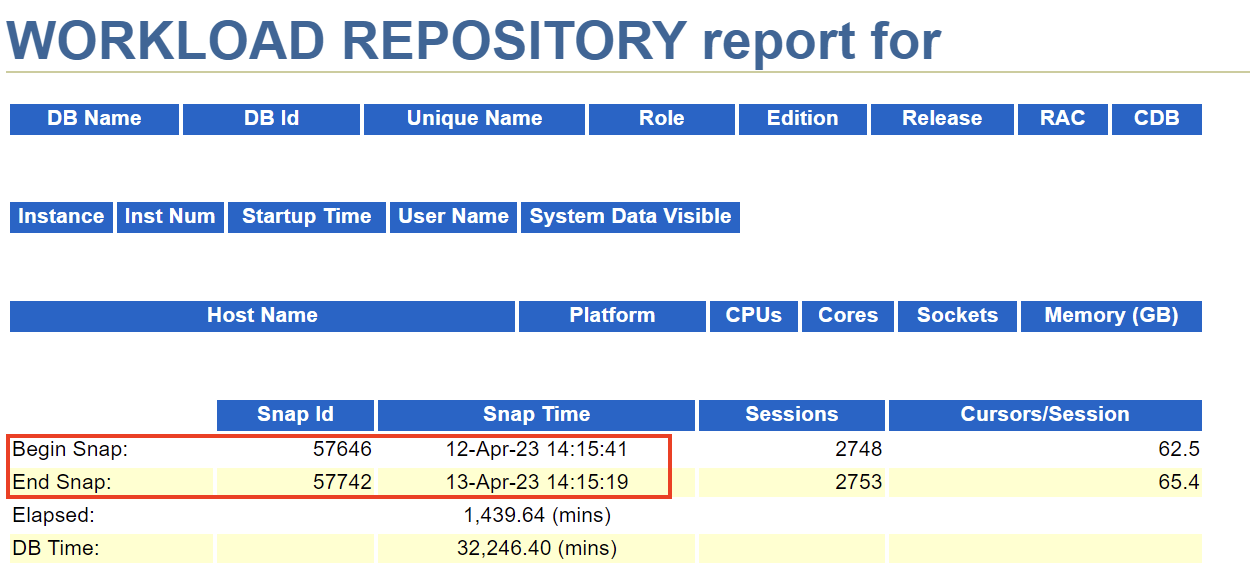Hello,
In my previous post, I showed how to see USED and PEEKED bind variables from SQL Monitor views, either in memory and/or from AWR repository.
In this new one, I show how to see these same values from Execution Plans (either GV$SQL_PLAN and/or DBA_HIST_SQL_PLAN) as well as from Captured SQL binds (either from GV$SQL_BIND_CAPTURE and/or DBA_HIST_SQLBIND).
So, here is the same test case I’ve created in the previous post:
create table t (
col_n number, col_ch char, col_vc varchar2(10),
col_dt date, col_ts timestamp);
Table created.
define mydt="2023/10/01 12:01:12"
define myts="2023/10/01 12:01:12.123"
insert into t values (
1, 'A', 'Edu$!123', to_date('&mydt','yyyy-mm-dd hh24:mi:ss'), to_timestamp('&myts','yyyy-mm-dd hh24:mi:ss.ff'));
1 row created.
Now let’s run a query with binds:
alter session set nls_date_format='yyyy-mm-dd hh24:mi:ss';
alter session set nls_timestamp_format='yyyy-mm-dd hh24:mi:ss.ff';
set serveroutput on
declare
n number;
c char;
vc varchar2(10);
dt date;
ts timestamp;
function run_query
return number is
rn number;
begin
select COL_N
into rn
from t
where COL_VC!='MYQUERY3'
and COL_N = n
and COL_CH = c
and COL_VC like vc
and COL_DT = dt
and COL_TS = ts
;
return rn;
exception when no_data_found then return (-1);
end;
begin
n := 1;
c := 'A';
vc := 'Edu%';
dt := to_date('&mydt','yyyy-mm-dd hh24:mi:ss');
ts := to_timestamp('&myts','yyyy-mm-dd hh24:mi:ss.ff');
dbms_output.put_line(run_query);
n := 2;
c := 'B';
vc := 'ABC%';
dt := sysdate;
ts := systimestamp;
dbms_output.put_line(run_query);
end;
/
1
-1
Let me find the SQL_ID of my query:
select sql_id, executions, sql_text
from v$sql
where sql_text like q'[SELECT %COL_VC!='MYQUERY3'%]';
SQL_ID EXECUTIONS SQL_TEXT
------------- ---------- ------------------------------------------------------------
fb3gqgd87ac8h 2 SELECT COL_N FROM T WHERE COL_VC!='MYQUERY3' AND COL_N = :B5
1 row selected.
Now, here is the script to get the bind values from the SQL Plans:
col bind_name format a10 wrap
col peeked_value format a40
col datatype head "DATA_TYPE" for a20
col src for a9
def sqlid="fb3gqgd87ac8h"
def datini=sysdate-1
def datfin=sysdate
select src, INST_ID, sql_id, plan_hash_value, child_number, c.bind_name, c.bind_pos, c.bind_type,
decode(bind_type,1,'VARCHAR2',2,'NUMBER',12,'DATE',96,'CHAR',180,'TIMESTAMP',181,'TIMESTAMP WITH TZ',231,'TIMESTAMP WITH LTZ',to_char(bind_type)) datatype,
case
when c.bind_type = 1 /*varchar2*/ then utl_raw.cast_to_varchar2(c.bind_data)
when c.bind_type = 2 /*number*/ then to_char(utl_raw.cast_to_number(c.bind_data))
when c.bind_type = 96 /*char*/ then to_char(utl_raw.cast_to_varchar2(c.bind_data))
when c.bind_type = 12 /*date*/ then TO_CHAR(dbms_stats.convert_raw_to_date(c.bind_data),'yyyy-mm-dd hh24:mi:ss')
when bind_type = 180 /*timestamp*/ then
to_char(
to_timestamp(
to_char(
dbms_stats.convert_raw_to_date(hextoraw(substr(bind_data,1,14)))
,'yyyy-mm-dd hh24:mi:ss')
,'yyyy-mm-dd hh24:mi:ss')
+ numtodsinterval(nvl(to_number(hextoraw(substr(bind_data,15,8)),'XXXXXXXX')/1e9,0), 'SECOND')
,'yyyy-mm-dd hh24:mi:ss.ff9')
else 'Not printable'
end as peeked_value
from (
select 'SQLPLAN-M' src, sql_id, plan_hash_value, OTHER_XML, child_number, INST_ID
from gv$sql_plan
UNION ALL
select 'SQLPLAN-H' src, sql_id, plan_hash_value, OTHER_XML, to_number(NULL) as child_number, to_number(NULL) as INST_ID
from dba_hist_sql_plan
join dba_hist_snapshot using (DBID)
where END_INTERVAL_TIME between &datini and &datfin
) p,
xmltable
(
'/*/peeked_binds/bind' passing xmltype(p.other_xml)
columns
bind_name varchar2(30) path './@nam',
bind_pos number path './@pos',
bind_type number path './@dty',
bind_data raw(2000) path '.'
) c
where sql_id = '&sqlid'
and p.other_xml is not null
order by src, inst_id, sql_id, plan_hash_value, child_number, bind_pos, peeked_value
/
SRC In SQL_ID PLAN_HV CHILD_NUMBER BIND_NAME BIND_POS BIND_TYPE DATA_TYPE PEEKED_VALUE
--------- --- ------------- ------------ ------------ ---------- ---------- ---------- -------------------- ----------------------------------------
SQLPLAN-M 1 fb3gqgd87ac8h 1601196873 0 :B5 1 2 NUMBER 1
SQLPLAN-M 1 fb3gqgd87ac8h 1601196873 0 :B4 2 96 CHAR A
SQLPLAN-M 1 fb3gqgd87ac8h 1601196873 0 :B3 3 1 VARCHAR2 Edu%
SQLPLAN-M 1 fb3gqgd87ac8h 1601196873 0 :B2 4 12 DATE 2023-10-01 12:01:12
SQLPLAN-M 1 fb3gqgd87ac8h 1601196873 0 :B1 5 180 TIMESTAMP 2023-10-01 12:01:12.123000000
5 rows selected.
NOTE: you can get peeked values from SQL Plans direct in your execution plan. Maria Colgan explains how you can do that here.
And here is the script to get the bind values from the Captured binds:
col bind_name format a10 wrap
col captured_value format a40
col DATATYPE_STRING for a20
col src for a9
def sqlid="fb3gqgd87ac8h"
def datini=sysdate-1
def datfin=sysdate
select DISTINCT src, INST_ID, sql_id, plan_hash_value, child_number,
name as bind_name, position as bindpos, DATATYPE_STRING,
case
when DATATYPE in (1,2,96) /*varchar2,number,char*/ then VALUE_STRING
when DATATYPE = 12 /*date*/ then to_char(anydata.accessDate(value_anydata),'yyyy-mm-dd hh24:mi:ss')
when DATATYPE = 180 /*timestamp*/ then to_char(anydata.accesstimestamp(value_anydata),'yyyy-mm-dd hh24:mi:ss.ff9')
else 'Not printable'
END captured_value
from (
select 'CAPTURE-M' src,
sql_id, child_number, PLAN_HASH_VALUE, INST_ID,
name, position, datatype, DATATYPE_STRING, value_string, value_anydata
from gv$sql_bind_capture
join gv$sql s using (INST_ID, sql_id, child_number)
UNION ALL
select 'CAPTURE-H' src,
sql_id, to_number(NULL) as child_number, to_number(NULL) PLAN_HASH_VALUE, INSTANCE_NUMBER as INST_ID,
name, position, datatype, DATATYPE_STRING, value_string, value_anydata
from dba_hist_sqlbind
join dba_hist_snapshot using (DBID, INSTANCE_NUMBER, SNAP_ID)
where END_INTERVAL_TIME between &datini and &datfin
) c
where sql_id = '&sqlid'
order by src, INST_ID, sql_id, plan_hash_value, child_number, position, captured_value
/
SRC In SQL_ID PLAN_HV CHILD_NUMBER BIND_NAME BINDPOS DATATYPE_STRING CAPTURED_VALUE
--------- --- ------------- ------------ ------------ ---------- ---------- -------------------- ----------------------------------------
CAPTURE-M 1 fb3gqgd87ac8h 1601196873 0 :B5 1 NUMBER 1
CAPTURE-M 1 fb3gqgd87ac8h 1601196873 0 :B4 2 CHAR(32) A
CAPTURE-M 1 fb3gqgd87ac8h 1601196873 0 :B3 3 VARCHAR2(32) Edu%
CAPTURE-M 1 fb3gqgd87ac8h 1601196873 0 :B2 4 DATE 2023-10-01 12:01:12
CAPTURE-M 1 fb3gqgd87ac8h 1601196873 0 :B1 5 TIMESTAMP 2023-10-01 12:01:12.123000000
5 rows selected.
And that’s it for today.
See you next time!













